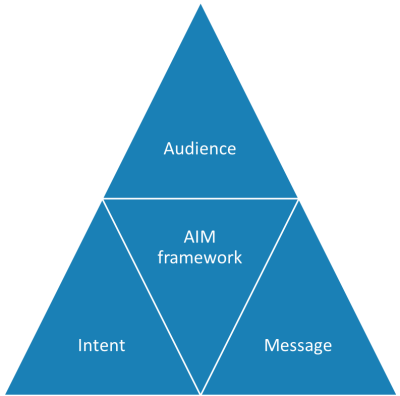 Project presentations require clear communication. Though clear communication does not guarantee a successful engagement, unclear communication certainly ensures failure. Therefore, effective communication can influence and inspire client action, shape outcomes, and produce results. In How Leaders Communicate Effectively, J.D. Schramm, Lecturer in Organizational Behavior at Stanford’s Graduate School of Business, presents the AIM Framework comprising of three powerful communications insights.
Project presentations require clear communication. Though clear communication does not guarantee a successful engagement, unclear communication certainly ensures failure. Therefore, effective communication can influence and inspire client action, shape outcomes, and produce results. In How Leaders Communicate Effectively, J.D. Schramm, Lecturer in Organizational Behavior at Stanford’s Graduate School of Business, presents the AIM Framework comprising of three powerful communications insights.
The AIM Framework
Schramm outlines a simple framework for preparing for communications of all kinds, including job applications. The AIM Framework poses three broad questions:
- Who is my Audience?
- What is my Intent?
- What is my Message?
This reflective exercise is a great way to pause and consider what you really want to say.
Audience
By defining what you would like to accomplish across the domains of audience, intention, and message, you will be in a much better position for your findings to be understood by client stakeholders.Most times, you cannot communicate with client teams face-to-face. You are limited to a phone calls, emails or video conferences. As businesses move further away from face-to-face communication, you lose two critical communication elements – body language and tone of voice. These two entities vastly influence how messages are conveyed and understood than the actual content (i.e. the words). This dilemma creates the need for you to understand your audience as completely as possible to craft a message that really resonates. By deeply understanding your audience, you can speak to them in a powerful, personal way. As you prepare you message, answer questions like:
- What challenges are they facing?
- How do the Critical Success Factors look like?
- What inspires them to action?
- Where do they gather information?
- What resources do they rely on?
- Who are their peer groups and influencers?
Try to gather as much information about your audience during workshops, meetings, social media profiles, publications, etc. The more you understand their background and context, the better you could customise your messaging.
Intent
Your intent is never simply to inform. If you’re just doing that, then you might as well simply put your information in an email and hit the send button. This is what we call the fire-and-forget approach and is a sure fire way to never drive action. Instead, you should try to motivate or inspire your clients to take some sort of action. At any rate, clearly define your goals. Too often, we see this aspect overlooked. Often, clients define goals that are either, too broad, ill-defined, unclear, or optimistic. At the least, you should try to answer the questions:
- What is it exactly that you want your audience to do with your recommendations?
- What are the concrete next steps?
- Who should complete certain actions? By when?
Be very specific.
Message
Only after you have deliberated the earlier points should you craft your message. Like intent, this must be clear too. Write it down. One sentence! Here’s the definition I learned from several client engagements. A message is
brief, memorable, repeatable, emotional and data-backed
But, it’s not only the data. While supportive, data dumps are dry and boring. Instead, your message should be a compelling call to action. It should coherently portray your intent / motivation! Don’t assume your audience just gets it.
Consider All Three Elements of Communication
There are three elements to communications . Schramm describes these elements as visual, vocal, and verbal. All three of the aspects of communication should work in harmony through your presentation. The more synchronised the elements are, the more effective will your communication be. Be mindful of how well you synchronize the three elements of communication to deliver a compelling message. The higher the stakes of the communication, the more important this becomes.




